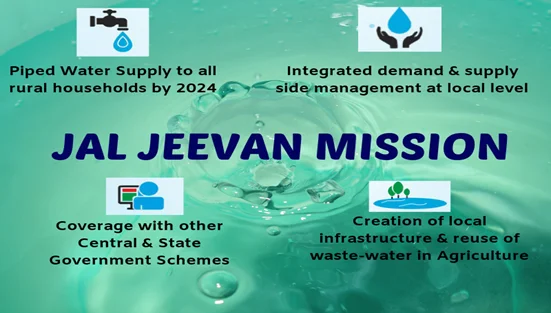Economics
In News: Pimpalghar-Ranjnoli, a village situated in the industrial belt of Thane district has used funds under the Jal Jeevan Mission (JJM) to ensure that all 842 families in the village get tap water connection.
- In other words, each of the 5,644 residents of the village has access to 55 litres of water every day.
- Under the JJM, the central government, in partnership with states, aims to provide potable water in adequate quantity and prescribed quality on a long-term basis to every rural household, including in tribal areas of the country, through tap water connection by 2024.
- While Pimpalghar-Ranjnoli can stand out as a model for the rest of the country, it is part of a broader effort by the state government to implement JJM.
- Maharashtra is one of the leading states in the country in implementing the JJM.
- As per the data from the central government, almost 71 per cent of households in Maharashtra have access to a tap connection; the national average is just under 52 per cent.
- By this metric, Maharashtra ranks ninth after Goa, Telangana, Haryana, Andaman and Nicobar islands, Punjab, Bihar, Himachal Pradesh and Manipur.
Jal Jeevan mission
- Launched in 2019, it envisages supply of 55 litres of water per person per day to every rural household through Functional Household Tap Connections (FHTC) by 2024.
- It comes under Jal Shakti Ministry.
- JJM looks to create a jan andolan for water, thereby making it everyone’s priority.
- The mission ensures functionality of existing water supply systems and water connections, water quality monitoring and testing as well as sustainable agriculture.
Features:
- JJM focuses on integrated demand and supply-side management of water at the local level.
- Creation of local infrastructure for source sustainability measures as mandatory elements, like rainwater harvesting, groundwater recharge and management of household wastewater for reuse, is undertaken in convergence with other government programmes/schemes.
- The Mission is based on a community approach to water and includes extensive Information, Education and Communication as a key component of the mission.

Implementation:
- Paani Samitis plan, implements, manages, operate and maintain village water supply systems.
- These consist of 10-15 members, with at least 50% women members and other members from Self-Help Groups, Accredited Social and Health Workers, Anganwadi teachers, etc.
- The committees prepare a one-time village action plan, merging all available village resources.
- The plan is approved in a Gram Sabha before implementation.
Funding Pattern:
- The fund sharing pattern between the Centre and states is 90:10 for Himalayan and North-Eastern States, 50:50 for other states, and 100% for Union Territories.
Source: Indian Express
Previous Year Question
Q.1) With reference to Ayushman Bharat Digital Mission, consider the following statements: (2022)
- Private and public hospitals must adopt it.
- As it aims to achieve universal health coverage, every citizen of India should be part of it ultimately.
- It has seamless portability across the country.
Which of the statements given above is/are correct?
- 1 and 2 only
- 3 only
- 1 and 3 only
- 1, 2 and 3
Q.2) Regarding ‘Atal Pension Yojana’, which of the following statements is/are correct? (2016)
- It is a minimum guaranteed pension scheme mainly targeted at unorganized sector workers.
- Only one member of a family can join the scheme.
- Same amount of pension is guaranteed for the spouse for life after subscriber’s death.
Select the correct answer using the code given below.
- 1 only
- 2 and 3 only
- 1 and 3 only
- 1, 2 and 3














